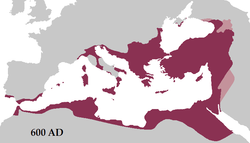| Years |
|---|
| Millennium |
| 1st millennium |
| Centuries |
| Decades |
| Years |
| 600 by topic |
|---|
| Leaders |
| Categories |
| Gregorian calendar | 600 DC |
| Ab urbe condita | 1353 |
| Armenian calendar | 49 ԹՎ ԽԹ |
| Assyrian calendar | 5350 |
| Balinese saka calendar | 521–522 |
| Bengali calendar | 6–7 |
| Berber calendar | 1550 |
| Buddhist calendar | 1144 |
| Burmese calendar | −38 |
| Byzantine calendar | 6108–6109 |
| Chinese calendar | 己未年 (Earth Goat) 3297 or 3090 — to — 庚申年 (Metal Monkey) 3298 or 3091 |
| Coptic calendar | 316–317 |
| Discordian calendar | 1766 |
| Ethiopian calendar | 592–593 |
| Hebrew calendar | 4360–4361 |
| Hindu calendars | |
| - Vikram Samvat | 656–657 |
| - Shaka Samvat | 521–522 |
| - Kali Yuga | 3700–3701 |
| Holocene calendar | 10600 |
| Iranian calendar | 22 BP – 21 BP |
| Islamic calendar | 23 BH – 22 BH |
| Japanese calendar | N/A |
| Javanese calendar | 489–490 |
| Julian calendar | 600 DC |
| Korean calendar | 2933 |
| Minguo calendar | 1312 before ROC 民前1312年 |
| Nanakshahi calendar | −868 |
| Seleucid era | 911/912 AG |
| Thai solar calendar | 1142–1143 |
| Tibetan calendar | ས་མོ་ལུག་ལོ་ (female Earth-Sheep) 726 or 345 or −427 — to — ལྕགས་ཕོ་སྤྲེ་ལོ་ (male Iron-Monkey) 727 or 346 or −426 |


Year 600 ( DC ) was a leap year starting on Friday of the Julian calendar. The denomination 600 for this year has been used since the early medieval period, when the Anno Domini calendar era became the prevalent method in Europe for naming years.